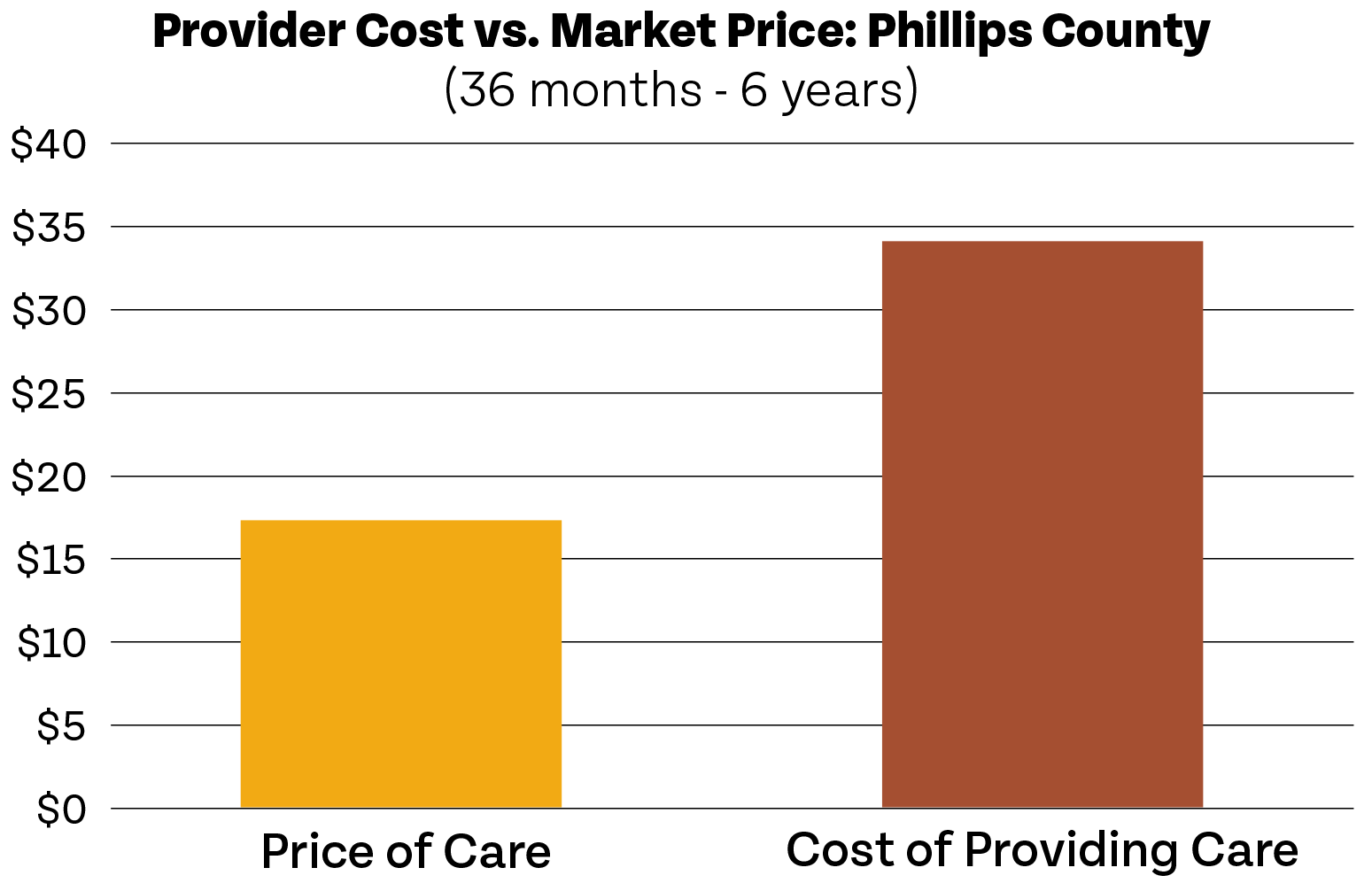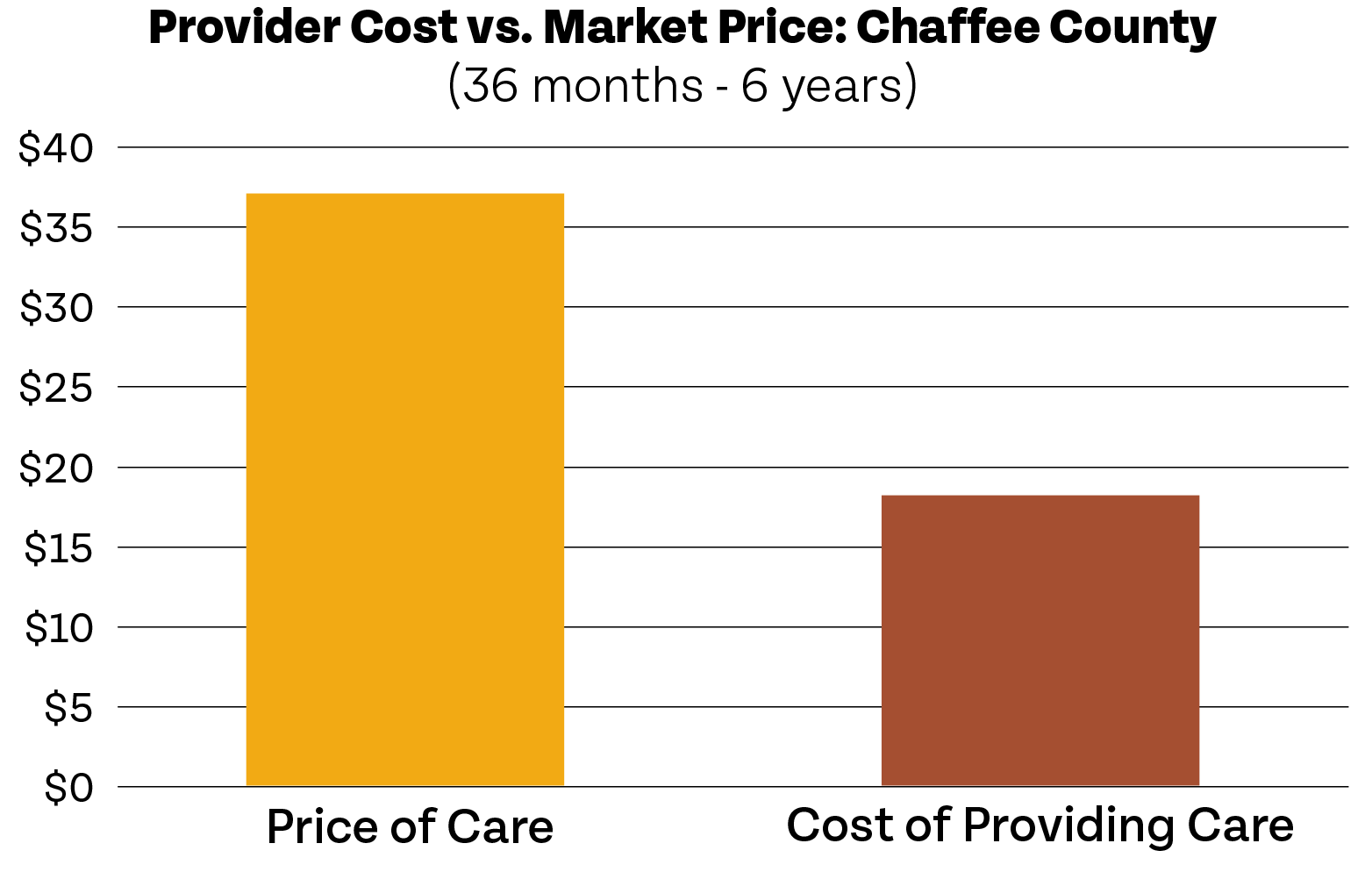Affordability of Care in Colorado
Affordability of Care in Colorado
Care provided across generations, through direct care (support for older adults and people with disabilities) or early childhood education (ECE), is crucial to our communities. Both types of care allow family members to work and have positive spillover effects in economic security, health, and well-being for the recipients of care and their family members.
A previous brief explored the accessibility of care. However, even when a family finds care, cost is still a common issue. Whether someone can afford care impacts their ability to use and benefit from it. We define affordability as the degree to which someone can pay for the service without compromising financial security. Currently in Colorado, with strained public investment and the high cost of providing the service, care remains a high, and in some cases prohibitive, cost to many families and people in search of care. Though data gaps make it difficult to understand the complete picture, care remains unaffordable in both rural and urban areas, areas with differing levels of accessibility, and for people of all incomes, though the burden is greatest for those with low and middle incomes.
Accessibility, affordability, and quality of care are closely tied and impact one another. However, for the purposes of this brief, we aim to define and explore the level of affordability in Colorado and analyze accessibility and quality in other briefs.
What Does Affordability Mean?
Affordability, as we are defining it here, means people can reasonably pay for and use high quality services. While value is an important piece of understanding cost, most people, regardless of income, would prefer high quality care. Therefore, value is not included in this definition.
The most common way to measure affordability is as a function of one’s income. This identifies how much should be spent on care, without compromising a person’s financial security. The ECE space has a clear measurement set by the Department of Health and Human Services: affordable child care should be no more than 7 percent of a family’s income. The income benchmark was applied to 1997-2011 Census data to determine that the average percent of monthly income spent by all families was consistently around 7 percent. However, as the Bipartisan Policy Center mentions, a flat income-based threshold does not necessarily adequately reflect the child care cost burden felt by families. Still, this measure provides a broad understanding of the child care costs Colorado families are facing.
The direct care space does not have the same measurement, nor is there an agreed upon measure for healthcare generally. However, for this paper, to understand the affordability of direct care, individuals should not spend more than 30 percent of their income on long-term care services, though this is likely still too large a proportion. Because there is no clear consensus on affordability in the direct care space, measuring how many people forgo care due to costs will also be used.
Why is Affordability Important?
The Bell has done extensive research on care and its importance for our communities. For older adults and people with disabilities, accessible care can allow them to live as independently as possible. It enables individuals to live in their community of choice, maintain social connections, and remain healthy. ECE engages children in activities, helps them grow socially and emotionally, and provides them with foundational skills for their continued education. Affordability of care will impact the ability to use and benefit from these services.
If care is unaffordable, people will rely on unpaid or informal care, more than they otherwise would have, from family members and friends. When this is the case, family members often will reduce their work hours to provide care, occasionally leave the workforce altogether, and forego wages. This can impact economic security and mobility.
Relying on informal sources is not always an option for people searching for care. As a result, they have no alternative to expensive care. Particularly for low-income families, when a large proportion of income goes toward care, budgets are often strained as a result, impacting their ability to cover other expenses such as food, transportation, and housing. Child care is often one of the largest expenses a family faces, leaving little leftover to save for retirement or a college fund.
Affordable care ensures that people can use needed care that allows them to remain healthy, age in their community of choice, and grow socially and emotionally. This in-turn leads to better long-term health, development, and financial benefits.
Early Childhood Education
What Does Affordability Look Like?
Across the country, child care remains one of the largest household expenses. In Colorado, many families face challenges in finding affordable child care. In 2022, child care expenses ranged from 13 to over 30 percent of median household income, depending on the setting of care, the ages of the children being cared for, and the quality of care. In all but one combination of provider type and age group, the increase of the price of child care exceeded changes in the statewide average cost of living. The table below shows that care is most expensive in centers, for infants and toddlers, and for Colorado Shines Quality levels 4 and 5.


Not only do the costs change based on the quality and setting of care, but the cost differs by region as well. The below analysis looks at the cost of center-based care, as it is the most commonly used type of licensed care. The two maps compare the percentage of household income spent on child care, for one child, by county and by age.
Using the 7 percent affordability benchmark, most of the state has unaffordable child care, with the most acute cost challenges being in infant and toddler care. For older children, the counties closest to the affordability benchmark are Phillips, Cheyenne, and Yuma counties. Here, families pay between 8 to 9 percent of their income on child care. Families in the most unaffordable counties, Washington, Mineral, and Chaffee, spend 27 percent to over 30 percent of their income on child care. Interestingly, both sets of counties are below the state median income (which is approximately $80,000), ranging between $50,000 to $69,000. They are also either rural or frontier counties, though the Front Range struggles with affordability as well. Additionally, the cost for the provider to offer care (referred to as the cost of providing care) in these areas is similar. Using the Bell’s ECE Child Care Cost Calculator, the daily cost of providing care (in a center for 3-year-olds), in both the most affordable and unaffordable counties, is $34 to $36 (although in other counties across the state the cost of providing care can be over $40 per day). The main difference in what makes one county more affordable is the price recipients of care must pay. The providers offering care in counties closer to the affordability benchmark are not covering the costs of providing care, while the regions with the most unaffordable care, are not only covering their costs, but exceeding the cost of providing care.
This trend is similar for infant and toddler care. The most unaffordable and relatively more affordable counties share similar incomes and costs of providing care, and those that are comparatively most affordable simply are not charging enough to cover the costs of providing care. For example, the most affordable counties for infant and toddler care are Cheyenne, Phillips, and Huerfano with median family incomes between $45,000 and $69,000 and the cost of providing care sits at $53 per day. The most unaffordable counties (Hinsdale, San Miguel, and Denver), apart from Denver, have median household incomes of $45,000 to $70,000 and providing care costs $56 per day. Denver county, the third most unaffordable county for infant and toddler care, is slightly higher both for median household income ($78,000) and the daily cost of providing care ($62 per day).
The graphs below illustrate this trend for the least and most affordable counties for older children and infants and toddlers.




While some of these numbers show providers charging significantly more than the cost of care, there are several important things to note. The market price identified in the survey does not vary based on quality level or whether the provider is caring for multiple ages at one time. This is important because providers may be charging more than the cost of care for 3- and 4-year-old to subsidize the high cost of also caring for infants and toddlers. Additionally, the assumptions used to calculate the cost of care include current wages and current distributions of quality. If providers are charging more than the cost, it is possible that they are of higher quality, pay higher wages, etc. When all these factors are considered, it showcases the challenges in the child care market; providers cannot cover their costs without care becoming unaffordable for families.
The chart below illustrates which counties are covering their costs, and by how much.
In the counties that are comparatively more affordable, particularly southeast Colorado, providers cover approximately half of their costs. Front Range providers are generally able to recover the costs of offering care. Notably, while the cost to families in Denver remains above the 7 percent affordability benchmark, it is not as challenging for families to afford care for 3 to 6-year-olds as in lower income counties. This shows that while all counties are unaffordable, the burden is not felt equally across incomes.
Important, however, is the range of counties between most and least affordable. No matter the income level, or the level of accessibility, the cost of providing care remains high, and is unaffordable for many families. However, the burdens are not felt equally, as low-income families will struggle to pay for care more than high-income families.
What is Being Done to Address Affordability?
Colorado Child Care Assistance Program (CCCAP) is both a federally and state funded program. The program helps low-income families, families that are homeless, working, or searching for work with child care assistance and will pay a predetermined rate to the child care provider. Families may be subject to paying an additional fee based on their income level, which is paid directly to the provider. The map below shows the proportion of providers in each county who accept CCCAP.
The most unaffordable counties for center-based child care (36 mos.- 6 years) also have a higher proportion of providers accepting CCCAP. All three counties, Washington, Mineral, and Chaffee have over 70 percent of providers accepting CCCAP. Though it should be noted that the counties with the highest percentage of providers accepting CCCAP have few licensed facilities. However, most counties range between 40 to 60 percent of providers accepting CCCAP, with only a few below a 30 percent participation rate. Notably, 24.5 percent of providers that are actively accepting CCCAP, report not having any children using CCCAP enrolled in their programs.
CCCAP faces several challenges in growing provider participation. According to Colorado’s Child Care Market Rate Survey, the most commonly reported barrier to CCCAP participation is low reimbursement rates followed by added administrative duties, and the inability to follow the same policies for private pay. Despite this, findings from the survey indicate that CCCAP rates are generally similar to market rates. However, in some rural counties, CCCAP rates did not cover the cost of providing care (as shown below in Alamosa County). In some urban counties, the CCCAP rates were sufficient, and even higher than the cost of care (as shown below in Denver County), though this may not be enough to account for the additional burdens of participating.


In addition to CCCAP, the Colorado Preschool Program funds either half or full day preschool programs for children considered to be at risk of later failure. While this program is state funded, it is implemented locally. This program is being replaced by the new Universal Preschool Program (UPK) set to begin in the Fall of 2023. UPK will fund at least 15 hours of preschool a week for every 4-year-old in the state. This can be expanded to 30 hours, and to some 3-year-olds with qualifying factors. While its success is yet to be seen, it is projected to save participating families $6,000, making care for 3- and 4-year-olds more affordable.
There have been other local initiatives to reduce the cost of child care through various taxes which subsidize care for families with low incomes, such as the Denver Preschool Program and Summit Pre-K. But these efforts are isolated to the few communities who have chosen to support early childhood initiatives.
Direct Care
What Does Affordability Look Like?
The cost of care for older adults is a well-recognized barrier to accessing and using different forms of health care. According to Colorado Health Institute’s (CHI) community health access survey, 19.6 percent of all Coloradans skipped some form of health care due to cost. While this is not specific to older Coloradans, they are not immune to similar circumstances. As seen below, direct care services can be expensive. Most older adults prefer to receive care in their home and community settings, which is less expensive compared to a nursing home.

Direct care costs also vary by region and take up a large proportion of people’s incomes if they are paying privately. There are large gaps in data statewide, but the chart below compares the cost of home care in various regions in Colorado to the median household incomes.

An older adult in each of these cities, if paying privately, is spending well above 30 percent of their income. The cost of care across the above cities remains similar, despite the large differences in median household income. The cost of care ranges from $28,000 to $37,000, while the median household incomes range from $38,000 to $80,000. As a result, it is often those with the highest incomes that can afford paid long-term services without public assistance from programs like Medicaid. Even so, Medicaid is only for those with low incomes, leaving those in the middle with difficult financial realities. It is reported that many older adults use retirement savings or Social Security to cover the costs of care, or in some cases spend down their assets to qualify for Medicaid. In a national study, it was found that only 3 percent of older adults could afford to pay for one year in a nursing home without using their assets. Additionally, the above-referenced Colorado cities are all found in urban counties and do not reflect the challenges seen in rural areas where the population is dispersed, and transportation poses an additional cost.
What is Being Done to Address Affordability?
The main public assistance someone might receive to pay for direct care services is Medicaid, which is the largest payor of these services. However, Medicaid has strict income eligibility requirements, and as mentioned above, older adults sometimes spend down their assets to qualify. The income requirements for Home and Community-Based Services (HCBS) Medicaid waiver are approximately $18,705 or less for a single person, or $24,353 or less for a two-person household. This is significantly lower than the median household incomes shown in the chart above, with which people already struggle to cover the high costs of care.
Informal Care
Above, we talk about formal child care and direct care because data is more widely available, but that is not the only type of care people rely upon. Informal care is also important and should be mentioned. There are many reasons that people may choose to use informal care and rely on friends and family including language, cultural responsiveness of care, and the flexibility it provides for different work schedules. In some cases, however, people choose informal care because of cost. Friends, Family, and Neighbor (FFN) care providers, for example, often charge less than the market price, charging only what families can afford. While families of all incomes rely on FFN care, families with low incomes are more likely to use FFN. Additionally, FFN caregivers in child care may be Qualified Exempt Providers, meaning they are legally exempt from licensing and can accept CCCAP. This helps ensure affordability for families relying on FFN while also supporting informal caregivers. In the direct care space, 18 percent of Coloradans provide unpaid care to an older friend or family member.
However, it is difficult to distinguish in a measurable way how many people choose to rely on informal care due to cost reasons as opposed to cultural reasons or due to a lack of available licensed care providers. Better data is needed about informal care workers to better support families and people in search of affordable, quality care and to better understand the choices people make in using care.
Conclusion
While public assistance for ECE and direct care should continue to be targeted to those who need it the most, it is clear the costs Coloradans are faced with when searching for care are too high for too many. Despite the above-mentioned initiatives, ECE and direct care remain a financial burden. Cost challenges can lead to people forgoing care, parents and family members leaving the workforce to provide care, and worse physical, mental, and developmental outcomes.



